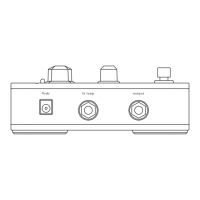25
About Phase and Anti-Feedback
There are two features provided to help control acoustic feedback, the
phase switch and the anti-feedback control.
Feedback usually occurs in the lowest octaves of your instrument. The
natural resonances which produce an instrument’s tone also react with
amplied sound. The louder an instrument is amplied, the more it will
interact. Feedback occurs when a note on the instrument resonates in
sync with the amplied sound, reinforcing and building to a sustained
howl.
The phase switch ips the polarity of your instrument signal from
positive to negative, changing its relationship to the sound coming from
the amplier. One phase setting usually provides better resistance to
feedback than the other and will vary depending on the instrument and
playing environment. Another approach to determining optimal phase is
the selection which sounds or feels most natural when playing.
The phase switch also affects the signal polarity to the balanced XLR
D.I. and 1/4 inch outputs, synchronizing the amplier with other sound
systems in use.
In certain playing environments the phase switch may not have an
audible impact.
The anti-feedback control is an automatic variable frequency notch l-
ter designed to subdue a resonant peak on the instrument which is prone
to feedback. Check out page 24 for more exact details of its operation.

